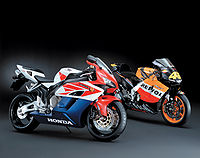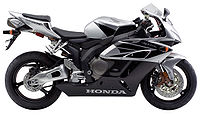2004 Honda CBR1000RR development
Consider this: Unlike the majority of new-model motorcycles, the lineage of the 2004 Honda® CBR®1000RR doesn't really reach into the past. True, Honda has crafted many other large-displacement transverse inline four-cylinder motorcycles in prior seasons, a rich tradition established in 1969 by the landmark CB750K0. But the new RR doesn't follow in the tire prints of those forerunners; it carries over no hardware from past machines.
A quick scan of the CBR1000RR's features confirms its newness. The compact 998cc in-line four is a completely fresh design, with unique bore and stroke dimensions, race-inspired cassette-type six-speed gearbox, all-new ECU-controlled ram-air system, dual-stage fuel injection, and center-up exhaust featuring a new computer-controlled butterfly valve. The chassis is likewise all new, including an organic-style aluminum frame composed of Gravity Die-Cast main sections and Fine Die-Cast steering head structure, inverted fork, Unit Pro-Link rear suspension, radial-mounted front brakes, and a centrally-located fuel tank hidden under a faux cover.
The roots of the CBR1000RR design stretch across the present and future, tapping wholesale into the cutting-edge technology from within Honda's world-dominating RC211V MotoGP racing program. For the past two years, the RC211V has stood head and shoulders above all would-be challengers, the uncontested champion in the rarified air of MotoGP racing. And that's where the heart of the CBR1000RR lies.

One of the main advantages of the RC211V is its ability to put power down early in the corners. While generating upwards of 200 horsepower from modern MotoGP machines is a relatively easy engineering task, managing that power, making the bike ridable and seeing a resultant drop in lap times is another matter altogether. The RC211V's long wheelbase, coupled with a lengthy swingarm and Unit Pro-Link® rear suspension, are credited for much of the bike's ability to start accelerating earlier than other machines when exiting corners, and it is here the CBR1000RR is most closely aligned to the RC211V's design philosophy.
Harnessing acceleration and creating a balanced, rider-friendly package in a modern liter bike--especially one destined to be transformed into a racing Superbike with significantly more power than the production model--presented CBR1000RR engineers with much the same challenges as those facing the RC211V's engineers. And the CBR1000RR team has taken the same engineering approach, a complex puzzle of component placement that begins at the business end of the CBR1000RR.
With the longest swingarm in the literbike class, the CBR1000RR reflects a Honda handling philosophy proven by the RC211V: a longer swingarm acts as a longer lever arm in the rear suspension for superior traction under acceleration and more progressive suspension action. Substantially longer than the corresponding unit on the CBR954RR--585mm compared to 551mm--the CBR1000RR's 34mm-longer swingarm now makes up 41.6 percent of its total wheelbase. The CBR1000RR's wheelbase has also increased, taping out at 1405mm (55.3 inches), a 5mm increase over the 954.
Providing room for a longer swingarm required massive changes to the engine architecture, another reason the CBR1000RR power plant shares nothing with the 954. Shortening the engine compared to the 954 meant rejecting the conventional in-line layout. Instead, engineers positioned the CBR1000RR's crankshaft, main shaft and countershaft in a triangulated configuration, with the countershaft located below the main shaft, dramatically shortening the engine front to back, and moving the swingarm pivot closer to the crankshaft.
Positioning this compact engine farther forward in the chassis also increases front-end weight bias, an effective method of making high-powered liter bikes less wheelie prone under hard acceleration. This approach, however, also provides very little space between the engine and front wheel for a large radiator. Engineers solved this problem by giving the RR a modest cylinder incline of 28 degrees, and moving the oil filter from its frontal placement on the 954 to the right side of the 1000RR engine. This allows the RR's center-up exhaust system to tuck closely to the engine, opening the space required for a massive MotoGP-style curved radiator with 40 percent more cooling capacity than the 954's unit--a key to making big horsepower with high durability.
Look closely at the 1000RR's engine, and you'll see that much was designed specifically with an eye toward handling as well as horsepower and torque. Why? Because the power plant represents a large percentage of a motorcycle's mass, the engine must be configured to assist the handling process, not hinder it. For decades, Honda has championed the concept of mass centralization, that is, concentrating the component masses as close to the motorcycle's center as possible. The CBR1000RR elevates that concept to a higher plane.
Renewed Emphasis on Mass Centralization[edit | edit source]
As a rider initiates a turn and then leans into the turn, the motorcycle rotates around its roll axis, an imaginary horizontal line running fore and aft through the center of mass of the bike and its rider. To create a motorcycle that responds quickly and smoothly to rider input, the major masses need to be placed as close to the bike's roll axis as possible. As an illustration in the opposite extreme, tightrope walkers are fond of carrying a long, weighted pole specifically because such a device slows down input and motion, which helps them remain stable while walking on that long, thin line.
Honda engine designers paid special attention to making the CBR1000RR power plant an extremely compact package to enhance mass centralization and reduce the roll polar moment, while yielding other benefits as well. Specifically, consider the RR's bore and stroke. While some engines employ ever-more oversquare dimensions, Honda employed a relatively modest 75mm bore with a 56.5mm stroke to derive a displacement of 998cc. This choice yields a remarkably narrow engine fit into a commensurately narrower chassis, all the better for increased mass centralization and improved ground clearance as well.
Other measures taken to enhance mass centralization in the CBR1000RR include positioning the starter motor and drive gear on the right side of the engine, which also creates a narrower engine profile for added ground clearance. The 1000RR incorporates a balancer shaft to virtually eliminate secondary engine vibration, and with an eye toward mass centralization it too has been positioned close to the engine's center of gravity.
Just as they did with the RC211V, Honda engineers looked at the CBR1000RR as an organic whole for centralizing mass. Placing other major masses--fuel and rider--closer to the roll axis results in a motorcycle that reacts more quickly and smoothly to control inputs at the handlebars. Like the RC211V and the CBR600RR, the CBR1000RR fuel tank shares space under a faux tank cover with a forward-mounted air box, thanks to the Unit Pro-Link rear suspension system.
The Unit Pro-Link design provides a wealth of benefits. To begin with, the shock is contained entirely within the swingarm, and the shock is positioned lower than in a conventional design. Both contribute to mass centralization, in part by giving the centrally mounted fuel tank room to extend downward. Because the shock is contained within the swingarm and does not require a top mount on the frame, the bulk of the 4.8-gallon tank can be positioned down low between the frame rails, close to the centerline of the machine. Two other benefits result from the RR's fuel placement; the mass of the fuel load has less effect on handling, thereby facilitating quick directional changes; and, because the fuel tank is shorter, the CBR1000RR rider sits closer to the steering head compared to the 954.
To achieve quicker handling, Honda engineers also lightened as many pieces as possible that are far from the center of mass. That gave rise to the RR's compact Line-Beam headlights, with their high-illumination three-piece reflectors; slim-line LED taillight; single-piston rear brake system that's lighter than that of the 954; an analog/digital fully electronic instrument panel that's one of the lightest and slimmest ever mounted on a street bike; plus a host of other changes.
Never before have the sum of the parts of a production street machine added up to such a greater overall whole. Perhaps that's the greatest legacy the CBR1000RR has inherited from its RC211V MotoGP racing roots.
